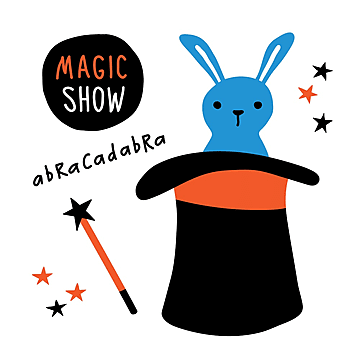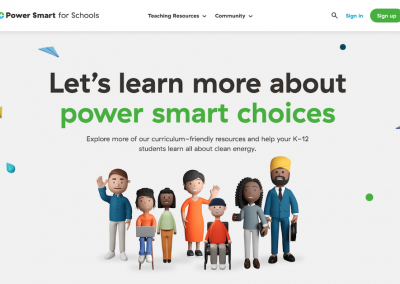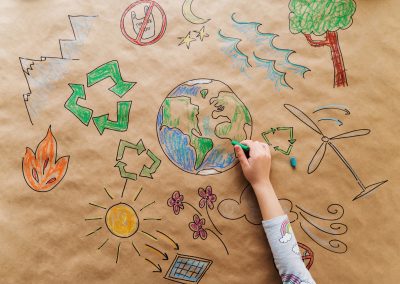*French resource included as attachment
Overview
In this hands-on and inquiry-based learning opportunity, primary students will discover 5 different types of energy for themselves – light, sound, growth, thermal, and motion through whole class “magic” demonstrations and rotating student stations. This experience will allow young learners to recognize that energy’s “magic” is all around them!
NB Curricular Connections
Explore Your World
- Strand: Play and Playfulness – Big Idea: Exploration and Problem Solving
- Strand: Play and Playfulness – Big Idea: Play and Inquiry
What You’ll Need
- PowerPoint Presentation: Energy Magic Show
 K-2 Energy Magic Show
K-2 Energy Magic Show - Magician’s Hat
- Pull-back race car
- Dancing Sprinkles: Large Glass/Ceramic Bowl, Plastic Wrap (to cover bowl), Rubber Band, Sprinkles
- Brightest Glow Stick Contest: Glowsticks (3), 3 see-through cups (glass or plastic), Cold water, lukewarm water, and hot water (kettle for nearby use) in each of 3 cups
- Elephant Toothpaste: Empty recyclable water/pop bottle, Safety Goggles, ½ cup of Hydrogen Peroxide, 1 tbsp of yeast, 3 tbsp. warm water, 1 clear cup for mixing yeast mixture, Food colouring (8 drops of 1 colour), 1 Tbsp. dish soap, small funnel, tray to hold material during experiment (it will expand and overflow)
- Station Cards #1-5 (see below)
- Voting Cards (see below)
Station #1 (Light Energy) – container, targets (with number of points on them included below), flashlight, masking tape, mirror, sunglasses, tally sheet, pencil, black tablecloth (if needed for darkness)
Station #2 (Motion Energy) – container, 100+ wooden dominoes
Station #3 (Heat/Thermal Energy) – container, 4 pairs of mittens, 80 ice cubes in a cooler, bag of chocolate chips, 10-20 coins, 10-20 pieces of crumbled tinfoil, voting sheet, pencil, timer
Station #4 (Sound Energy) – container, spinner, paper, piece of felt, cardboard, tissue paper, pillow, cups, large paperclip, unsharpened pencil, and animal cards
Station #5 (Growth Energy) – container, bucket, balloons, 3 plastic water/pop bottles (500ml), can of Pepsi, 5 packages of pop rocks, 2L vinegar, 2L lemon juice, box of baking soda, 6 funnels, safety goggles, adult supervision
Instructions
| Magic Act
Whole Group (15-20 minutes) |
Energy Stations
Teams of students rotating through 5 (6-8 minutes per station = 30-40 minutes) |
Energy Reflection Whole Group & Teams (10 – 15 minutes) |
1. DISCUSSION: Gather together in a large group and show slide 2 of the PowerPoint and have students think about this question: What is energy? Allow students to talk to an elbow partner beside them and have a few share their responses. THEN, reveal the answer on the PowerPoint and read it together (press space or forward arrow). Energy makes change! Next, let the students know that every time you say, “Energy”, they have to shout out, “makes change!”. Practice as many times as needed.
2. MAGIC SHOW ROUTINE: Having a table set up at the front of the room (and all materials from the list above that are NOT stations), put on your magician’s hat, and invite students who are attentively listening to be volunteers for your act. Be sure to introduce their name and have the audience give them a round of applause at the end of each trick.
Magic Act:
a) Vroom-Vroom Trick: Choose a volunteer to hold in their hands and show the crowd a Pull-Back Race Car. Then say, “Kaboom, Kaboom, now car go VROOM!” (Nothing should happen in the student’s hand.) Try it again! (Nothing). Have the student volunteer place the car on the floor and pull it back – but doesn’t let it go until you have said your phrase again. VOILA! Say, “Energy!” and the crowd should say, “Makes Change!” Have the audience applaud the volunteer. Ask the crowd, “What changed?” (The car changed from still to moving because pulling it back forced the wheels and parts inside to hold onto stretched energy and release it into motion/movement.)
b) Dancing Sprinkles Trick: Choose a volunteer to help set up this trick! Using the large glass bowl, rip a piece of plastic wrap to cover the top and have the student hold it tight while you place a rubber band around it. There should be NO wrinkles in the plastic. Next, have the student place some sprinkles on top of the plastic wrap. Next, tell the crowd that you will make these sprinkles dance without touching them! Say, “Wiggle Fancy, now dance, dance, dance-y!” (Nothing). Now, have the student volunteer get their mouth close to the side of the bowl facing the crowd. They cannot blow them but get the volunteer to hum (as loud as they can!), “Happy Birthday!” There may even be a member of the audience that they can hum in honor of. As they hum, the sound should vibrate through the plastic and cause the sprinkles to start moving on their own! VOILA! Say, “Energy!” and the crowd should say, “Makes Change!” Have the audience applaud the volunteer. Ask the crowd, “What changed?” (The sprinkles went from still to dancing because of the sound vibrations.)
c) Brightest Glow Stick Contest: Choose a student volunteer and have them hold 3 glowsticks (unbroken). Say, “Light start to flow and make this stick glow!” (Nothing.) Have your volunteer tell you why they are NOT glowing. (They need to be broken.) Have your volunteer crack them and see them glow. VOILA! Say, “Energy!” and the crowd says, “Makes Change!” Ask the crowd: “What changed in the glow sticks?” Students will respond that they were cracked but you can explain how glow sticks inside actually have a very thin layer of glass inside separating 2 different chemicals. Once broken, these chemicals mix together to create chemiluminescence or LIGHT. Using 3 clear cups, have your students volunteer help to fill up one with cold water, one with lukewarm water and YOU fill up the hot water from a kettle. Have the crowd vote on which cup will make the glow stick burn the brightest by clapping their VOTE as you point to each cup. (This one will take some time so move on to the next trick and come back to this after!)
d) Elephant Toothpaste: Choose a student volunteer to help you mix up your next batch of toothpaste for your pet elephant. Both you and your volunteer should wear safety googles. You can tell the crowd just how difficult it is to find elephant toothpaste in local stores so you usually whip up homemade batches instead. Make sure to have a deep tray to set the empty water/pop bottle on (as the mixture will overflow – BEST PART!). Have your volunteer pour the packet of yeast and some warm water into a clear cup to get that going. Then, have your volunteer place a funnel in your water/pop bottle. YOU pour the hydrogen peroxide into the bottle. Then, have your volunteer add 8 drops of food colouring (get the crowd to help count!) and a big squeeze of dish soap. Swirl it around a couple of times. Then, have your volunteer pour the yeast mixture in and VOILA! Say, “Energy!” and the crowd should say, “Makes Change!” (The mixture should turn foam-like and squirt out of the top of the bottle!) Ask the crowd: “What changed?” It GREW – when certain substances touch, they react in a way that it makes something new!
Go BACK to the glow sticks and reveal which one is the brightest! (It should be the hot water – even turn off the lights to be sure!). VOILA! Say, “Energy!” and the crowd should say, “Makes Change!” The hot water, or heat, forces the chemicals in the glow stick to burn brightest.
MAGIC SHOW Review – Now, go to Slide 3 of the PowerPoint and describe the 5 types of energy. Have the audience identify which tricks matched each type of energy.
Sound – Dancing Sprinkles
Growth – Elephant Toothpaste
Motion – Pull-back car
Light – Glow sticks
Thermal – Glow sticks (hot water)
Divide the crowd into 5 teams (grade level, mixed levels, etc.). Go around the room (stations should be set up before the magic act with numbered station cards placed at each station) and describe what to do at each station. DO NOT REVEAL WHICH ENERGY IS PRESENT AT EACH STATION AS THAT WILL BE AN ACTIVITY FOLLOWING THE STATIONS. ONLY REFER TO THEM BY NUMBER ONLY (Station #1, Station #2, etc.) It would be useful to have an adult, EA, or older student volunteer at each station for supervision. There MUST be an adult at Station 5. If your class size is small, you could lead them through each station together as one large group.
3. ENERGY STATIONS:
#1 – (Light Energy) Students will form a line. The person at the head of the line will wear a pair of sunglasses. They will use the mirror and try to “bend” the light from the flashlight to hit a target on the wall. Teammates will try to cheer each other on and tally up points to put on the chart at the station before leaving. (*If too bright, try placing targets on a wall under a table or using a black tablecloth angled from wall to floor to create some darkness.*)
#2 – (Motion Energy) – Students will work together to form a domino maze with about 2-3 cm between each upright domino. Then, they will count down 3, 2, 1 and push the beginning domino to see how their dominoes keep falling. Encourage students to be creative – try creating a letter of the alphabet, a shape, a number, etc.
#3 – (Heat/Thermal Energy) – Students will take turns holding objects in their hands for approx. 30 seconds – one hand is bare and the other has a mitten on it. Use an egg timer or an iPad timer for students to hold the objects for 30 seconds. Following the voting chart, students can start with crumbled tinfoil, 1 coin, chocolate chip and then an ice cube. Students will need to vote on which hand caused the greatest change as a team after each experiment.
#4 – (Sound Energy) – Students will take turns choosing an animal card. They are NOT to share which animal they picked. Next, they spin the spinner and whichever product that the spinner lands on (felt, cardboard, tissue paper, cup, or pillow) the student must hold that between their mouth and their team as they describe their animal to their teammates. The team will try to guess the animal….and listen closely!
#5 – (Growth Energy) – Students will try to make a balloon blow up WITHOUT using their breath! Safety googles must be worn for this one! Give each student in the team a job – 3 will need to fill up balloons (each using a funnel and 2-3 tbsp. baking soda x2 and 1 small package of pop rocks) and 3 will need to fill up the clear water/pop bottles with 1-2 cups of vinegar, lemon juice, and pepsi. One at a time, have students place a balloon onto the top of the filled bottle and then kind of push down the baking soda or pop rocks into the liquid. Stand back and watch the balloons blow up (they should not explode but look like they have been blown up.)
1 bottle – Pepsi & Pop Rocks
1 bottle – Vinegar & Baking Soda
1 bottle – Lemon Juice & Baking Soda
4. ENERGY TYPE CHALLENGE: Have teams sit together and join you at a meeting place in the room. Then, give each team 5 voting cards (included below). Teams will place the card with the type of energy they feel was represented at each station. Give 1 minute for them to place their cards by the stations.
5. WRAP-UP: REVEAL the voting card answers with Slide 4 of the PowerPoint. Then, review each station’s data:
Station 1 – Review high scores and clap for each team
Station 2 – Have teams share about any cool mazes they created
Station 3 – Review the chart to see if bare hands or mittens caused the MOST change
Station 4 – Ask, “Which material was the most difficult to hear through?”
Station 5 – Ask, “Which balloon mixture grew the biggest?”
Use Slide 5 to ask students: What types of energy do you use each day? Have them clap if they use the type of energy that you mention. (Light, Motion, Heat, Sound, Growth). Using Slide 6, introduce students to careers which use these types of energy on a daily basis. If time permits, discuss other careers suggested by students.
Reflection Activity
Please see the attached PDF for several choices on how you and your learners can reflect upon today’s activity.




